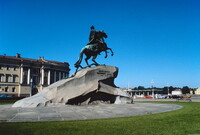Peter the Great
Falconet, Etienne-Maurice; Falconet, Marie Anne; Catherine II, Empress of Russia

Download1A2-R-SU-A3_cp.jpg (374.5Kb)
Alternative Titles
Bronze Horseman
Mednyi vsadnik
Date
1766-1782Description
Looking northwest, the Senate and Synod buildings in the background; Through Denis Diderot, Falconet was introduced to the Empress Catherine the Great, who commissioned from him a bronze equestrian statue in honour of Peter the Great in St. Petersburg, an opportunity at last to give full scope to his talent. Initially much in favour with Catherine, Falconet saw his position gradually deteriorate, and he had to leave Russia before his work was unveiled in 1782. The originality of his conception--which combines a horse rearing on the summit of a steep rock with a hero represented as legislator rather than conqueror, eliminates any allegorical figure apart from the serpent of envy crushed beneath the horse’s hoofs, and has an inscription of only four words--makes the statue striking in its grandeur and simplicity. The head of the statue was modelled by his pupil Marie-Anne Collot [Falconet]. Pushkin wrote his famous poem "The Bronze Horseman" about the statue in 1833. The base was an immense boulder called the "thunder stone" which was calculated to be 7 x 14 x 9 meters before sculpting. Source: Grove Art Online; http://www.oxfordartonline.com/ (accessed 4/1/2009)
Type of Work
equestrian statueSubject
rulers and leaders, Peter I, Emperor of Russia, 1672-1725, rearing horse, serpent, tsar, Eighteenth century
Rights
Rights Statement
Licensed for educational and research use by the MIT community only